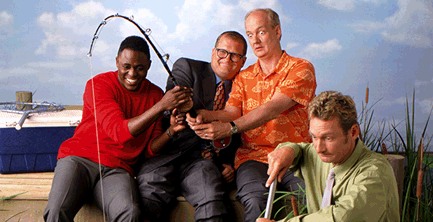It’s almost a scientific fact that any human being, no matter how depressed or cynical, will laugh to the point of tears while watching an episode of “Whose Line Is It Anyway?” The skits are unexpected and irreverent, and the comedians can barely keep it together most of the time.
The secret’s in the teamwork. The players are talented individually, but the more important thing is that they’re attuned to one another. They’re able to play off each other’s ideas and energy to create skits that are original and can make even the most serious viewer crack a smile.
“Yes, and…”
There’s only one rule in improv: Players can never say “no” to one another.
It sounds simple, but this rule is the pillar of good improv performance.
During an improv game, the players have access to a sea of ideas — their own, their group’s, and the audience’s. Some are immediately funny; many are not. But the group has to say “yes” to the idea and work through it to determine whether it’s a failure.
In that way, good improv has a lot in common with innovation. Both are based on the inherent potential of ideas. And to be either funny or innovative, you need to be spontaneous, responsive, and willing to take risks.
That’s why adopting the golden rule of improv — saying, “Yes, and…” instead of “no, but…” — is the key to unlocking your capacity for innovation.
Treat innovation like improv, and this is what happens:
1. The Scene Stays Alive
There are few things more painful than watching an improv group struggle with a scene that’s died. All the actors are spinning, trying to find a way forward. But everything they say or do sounds forced.
You’ve probably experienced something similar in a work environment. Every brainstorm session rides a precarious line between life and death. When your team members don’t listen to one another or they fail to recognize and build upon each other’s ideas, the brainstorm fails — meaning early-stage innovation dies.
On the other hand, acknowledging every idea with a “yes, and…” fuels the scene. It accepts the original idea and offers a way to improve. This keeps potential paths toward innovation alive and illuminated.
2. The Burden of Evidence Disappears
To kill off a new idea, simply utter the phrase, “Prove it.” This burden of evidence sets an almost impossible threshold for innovative solutions.
There’s a large software company that demands employees back up every new idea with hard data. This isn’t necessarily a bad thing in terms of commercialization, but it’s a scorched earth policy for early-stage innovation.
If the company were to change from “prove it” to “yes, and…,” employees wouldn’t pre-screen their ideas based on what they could back up with evidence. The team would have the freedom to unleash their creative capacity. Later on, once their ideas were more fully formed, they could shift to an analytical perspective. In the early stages, however, the team needs to be able to create without wearing blinders.
3. Ideas Get the Oxygen They Need to Mature
When you decant a bottle of red wine, you’re exposing it to oxygen. And when wine breathes, it becomes more expressive, releasing and amplifying its hidden aromas and flavors.
Ideas are the same. Give an idea some breathing space. Discuss it, play with it, build upon it, and you’ll unlock its full potential. Using “yes, and…,” as a decanter enables an average idea to mature into a great one.
4. Leaders Leave the Path of Least Resistance
Most leaders have developed a capacity for quickly assessing a situation based on limited data and then making rapid decisions to keep the operation moving forward. Essentially, leadership is motivated to find the path of least resistance, which is usually the safest, most feasible, and most proven option.
In human-centered design, however, a leader’s main goal is not to find the path of least resistance; it’s to generate innovation. And for innovation to flourish, there must be a free flow of ideas.
So when a leader says, “Yes, and…,” she transforms herself from a judge into a facilitator, opening up collaborative spaces in which team members connect to build something together.
Experimenting, Failing, and Learning
If you’ve ever worked in a startup, you know it would be impossible to approve every single idea. How would you ever get anything done?
However, embedding the “yes, and…” mindset isn’t about making your organization less efficient. It’s about seizing the opportunity to try new things without fear of failure. Every interaction you have with your team and with your clients is a platform for experimentation. Every idea is an opportunity to collaborate on creating something unique.
When you experiment, it’s inevitable that most of your ideas will fail. Who cares? As Thomas Edison said before he invented the first commercial light bulb, “I have not failed. I’ve just found 10,000 ways that won’t work.”
Failure isn’t a dead end. It’s simply a new way forward. A failure without a lesson learned is a wasted opportunity.
As you and your organization experiment, fail, and learn, you’ll be creating the conditions for innovation to thrive. Eventually, once the “yes, and…” philosophy takes root, fear and ego will give way to playfulness and excitement.
So take a risk and say yes. And don’t be hesitant to write off the “Whose Line Is It Anyway?” box set as a business expense.
Andrew (Drew) C. Marshall is the Principal of Primed Associates, an innovation consultancy. He lives in central New Jersey and works with clients across the U.S. and around the world. He is a co-host of a weekly innovation-focused Twitter chat, #innochat; the founder, host, and producer of Ignite Princeton; and a contributor to the Innovation Excellence blog. He is also providing support for the implementation of the Design Thinking for Scholars model with the Network of Leadership Scholars (a network within the Academy of Management).
Image Credit: www.hypable.com





